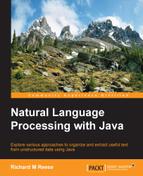Natural Language Processing (NLP) is a broad topic focused on the use of computers to analyze natural languages. It addresses areas such as speech processing, relationship extraction, document categorization, and summation of text. However, these types of analysis are based on a set of fundamental techniques such as tokenization, sentence detection, classification, and extracting relationships. These basic techniques are the focus of this book. We will start with a detailed discussion of NLP, investigate why it is important, and identify application areas.
There are many tools available that support NLP tasks. We will focus on the Java language and how various Java Application Programmer Interfaces (APIs) support NLP. In this chapter, we will briefly identify the major APIs, including Apache's OpenNLP, Stanford NLP libraries, LingPipe, and GATE.
This is followed by a discussion of the basic NLP techniques illustrated in this book. The nature and use of these techniques is presented and illustrated using one of the NLP APIs. Many of these techniques will use models. Models are similar to a set of rules that are used to perform a task such as tokenizing text. They are typically represented by a class that is instantiated from a file. We round off the chapter with a brief discussion on how data can be prepared to support NLP tasks.
NLP is not easy. While some problems can be solved relatively easily, there are many others that require the use of sophisticated techniques. We will strive to provide a foundation for NLP processing so that you will be able to understand better which techniques are available and applicable for a given problem.
NLP is a large and complex field. In this book, we will only be able to address a small part of it. We will focus on core NLP tasks that can be implemented using Java. Throughout this book, we will demonstrate a number of NLP techniques using both the Java SE SDK and other libraries, such as OpenNLP and Stanford NLP. To use these libraries, there are specific API JAR files that need to be associated with the project in which they are being used. A discussion of these libraries is found in the Survey of NLP tools section and contains download links to the libraries. The examples in this book were developed using NetBeans 8.0.2. These projects required the API JAR files to be added to the Libraries category of the Projects Properties dialog box.
A formal definition of NLP frequently includes wording to the effect that it is a field of study using computer science, artificial intelligence, and formal linguistics concepts to analyze natural language. A less formal definition suggests that it is a set of tools used to derive meaningful and useful information from natural language sources such as web pages and text documents.
Meaningful and useful implies that it has some commercial value, though it is frequently used for academic problems. This can readily be seen in its support of search engines. A user query is processed using NLP techniques in order to generate a result page that a user can use. Modern search engines have been very successful in this regard. NLP techniques have also found use in automated help systems and in support of complex query systems as typified by IBM's Watson project.
When we work with a language, the terms, syntax, and semantics, are frequently encountered. The syntax of a language refers to the rules that control a valid sentence structure. For example, a common sentence structure in English starts with a subject followed by a verb and then an object such as "Tim hit the ball". We are not used to unusual sentence order such as "Hit ball Tim". Although the rule of syntax for English is not as rigorous as that for computer languages, we still expect a sentence to follow basic syntax rules.
The semantics of a sentence is its meaning. As English speakers, we understand the meaning of the sentence "Tim hit the ball". However, English and other natural languages can be ambiguous at times and a sentence's meaning may only be determined from its context. As we will see, various machine learning techniques can be used to attempt to derive the meaning of text.
As we progress with our discussions, we will introduce many linguistic terms that will help us better understand natural languages and provide us with a common vocabulary to explain the various NLP techniques. We will see how the text can be split into individual elements and how these elements can be classified.
In general, these approaches are used to enhance applications, thus making them more valuable to their users. The uses of NLP can range from relatively simple uses to those that are pushing what is possible today. In this book, we will show examples that illustrate simple approaches, which may be all that is required for some problems, to the more advanced libraries and classes available to address sophisticated needs.
